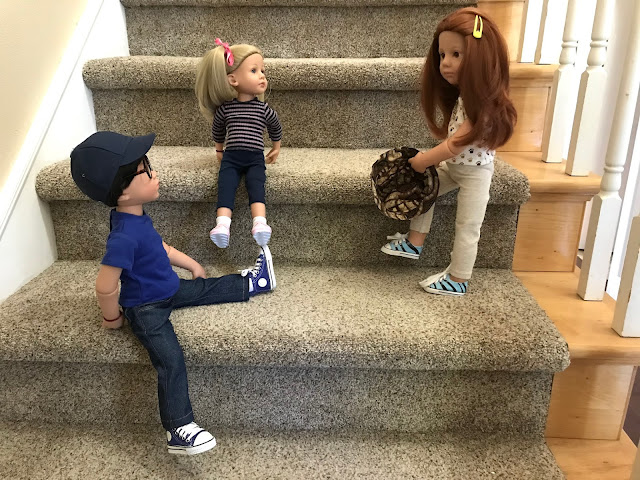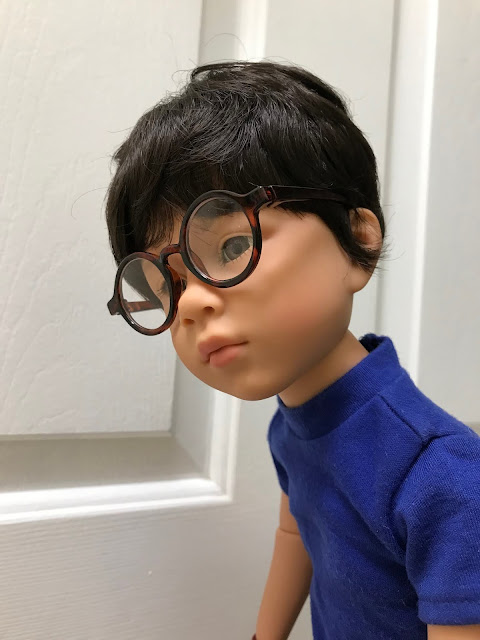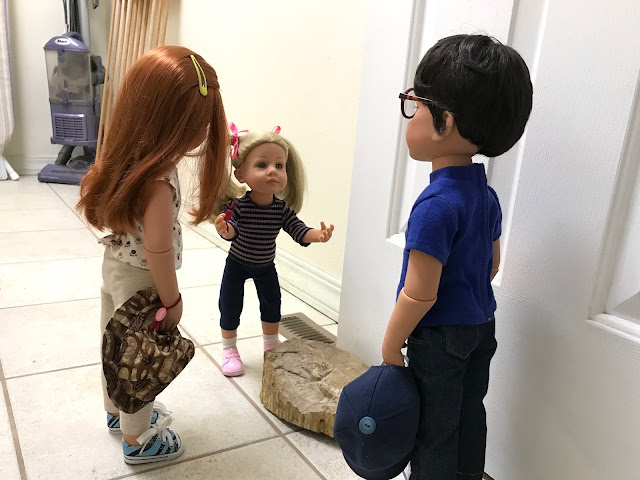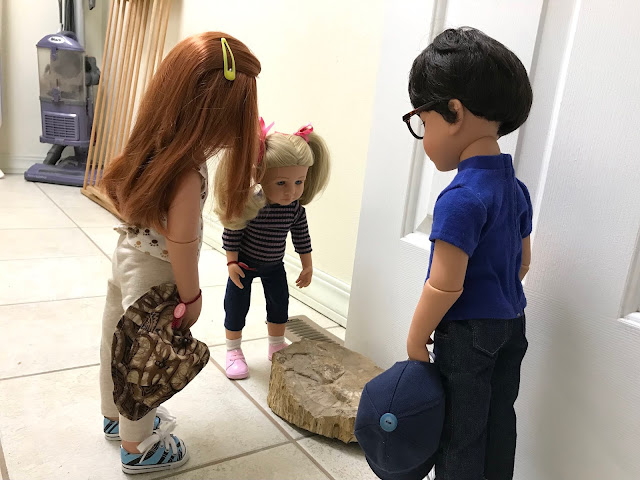"Why is this piece of wood so heavy?" Pippa asked Emil as they walked into the workroom. "I can't even pick it up!"
Emil looked at the doorstop. "I guess that's why the old people use it for a doorstop," he said, "but I don't know why it's so heavy. Maybe it's a special kind of wood." Then he thought for a moment. "You know," he said, "I would like to know that, too. Let's ask Mandy!"
It just so happened that Mandy was already in the workroom, picking out some yarn to make Pippa a sweater for the cooler weather that she knew was coming.
"Mandy," Emil began, "we were wondering why the piece of wood we use for a doorstop is so heavy."
Mandy put down the yarn she was holding. "It's heavy because it's petrified," she explained.
"You mean the wood is scared?" Pippa asked.
"No," Mandy laughed. "Something is petrified when it's turned to stone. We say someone is petrified when we want to say they are so frightened they can't move, but that expression comes from things that are actually petrified, like wood that has turned into rock."
"Most petrified things are or were wood," Mandy continued, "but anything that was once alive can turn to stone if the conditions are right."
"What are conditions?" Pippa asked.
Mandy looked at Emil to see if he knew how to answer Pippa's question. She always tries to let others explain things they already know. Mandy doesn't need to show off.
"I think that means that all the things that can affect what happens to something are a certain way," he said. "I don't know what conditions it takes for something to turn to stone, though," he added.
"Well," Mandy urged, "what usually happens to living plants when they die?"
Emil thought about that.
"They rot and turn into compost!" Emil exclaimed suddenly, "like how we make compost for the garden!"
"Yes," Mandy agreed.
"The parts of fruits and vegetables we don't eat," Emil explained to Pippa, "and grass and other clippings from the landscaping go into the composter, where they rot or decay and turn into compost to nourish the plants in the garden, but they can also lie around where they died, and the same thing happens, but more slowly."
"Do you remember what is needed for things to rot or decay?" Mandy asked.
Pippa looked from one to the other, expectantly.
"I think you said you need a little water, some insects and other creatures, some too small to see without a microscope," Emil said. "You also said you need oxygen, just like human people need to breathe."
"That's right!" Mandy agreed. "Most wood decays (or rots) when it lies around. Insects eat it and it falls apart. It becomes part of the soil it came from."
"Sometimes, though," Mandy continued, "a tree or parts of trees fall over and are covered up quickly by sand or mud or something called ash, which comes from volcanoes. Insects can't get at the wood, and it doesn't rot or decay."
"So how does it turn to stone?" Pippa asked.
"Water can get still into where the wood is," Mandy explained, "even after the mud and sand and ash have turned to rock. The water gets into the cells and the tiny spaces in the wood and brings with it minerals––that's what rock is made up of––and the minerals harden. After a long time, the wood is mostly rock, but very hard, heavy rock. Then we say it's petrified."
"How long does that take?" Pippa wanted to know.
"Usually millions of years," Mandy told her.
"But this piece of petrified wood isn't inside a rock," Emil pointed out.
"That's right!" Mandy agreed. "The rock it was in has been worn away. After many years of weather, the softer rock surrounding the petrified wood can wear away. We can find pieces of this wood, which has been turned to rock, where the surrounding rock is gone."
"It still looks like wood, though," Emil pointed out.
"It does," Mandy agreed, "and sometimes you can actually see the original rings in the wood, the way you can see the rings in a tree that has been cut down. Come, and I'll show you."
Pippa and Emil followed Mandy into the laundry room. There was another piece of petrified wood on the floor, holding that door open.
The dolls could see that it looked like a piece of a log that had been cut. It was heavy and hard to pick up, but Mandy wanted them to be able to look at the rings, so she gently turned the rock to lie flat. She did it carefully, because she didn't want to damage the floor.
"This piece of wood was buried 200 million years ago," Mandy said. It was inside rock for much of that time.
The dolls looked at the piece of petrified wood. They could just make out the rings from the original wood.
"When we were hiking in the forest, I remember seeing rings in a tree stump," Emil said.
"Yes," Mandy agreed.
"Pippa hasn't seen them," Mandy said. "Pippa, would you like to go for a hike and look at some tree stumps where trees have been cut down?"
"Yes!" Pippa exclaimed. She didn't get to go out in the woods very often.
Mandy and Emil put on their hats, and the dolls let themselves out the front door. When they got to the place on the street that was across from the entrance to the trail, Mandy took Pippa's hand. "Hold my hand," she said, "so I don't accidentally run out in front of a car or a bicycle."
All three dolls looked both ways before they crossed.
"I think I remember where there were a few trees that had been cut down and showed the rings," Mandy told them as they walked along the trail.
Then Mandy stopped. "Here's this one." she said. "It hasn't been cut for too long. You can see the rings. Someone cut the tree to make a seat, but you can see the rings where they cut across the trunk of the tree."
"Why do trees have rings inside them?" Pippa asked.
"To get bigger, trees grow just under their skin, which we call bark," Mandy explained.
"Like when a dog yells at you?" Pippa asked.
"It's the same word," Mandy agreed, "but in this case it's used to mean the skin of a tree. Trees don't grow at the same rate all the time," Mandy continued. "Sometimes they grow faster, and sometimes the growing slows down. In the winter, the trees stop growing or hardly grow at all. Then in the spring, they start to grow again. That leaves a ring where the growing stopped. Scientists can tell how old a tree was when it was cut down by counting the rings."
"Tree rings are good for more than telling a tree's age, though," Mandy explained. "Scientists can learn things like if there was a lot of rainfall or a long time without any rain, just by looking at the rings."
The dolls moved on to another tree a little further along on the trail. The rings looked almost the same, but they were further apart, and they weren't as even. "These trees lived close together," Mandy pointed out. "They lived through some of the same weather, and they certainly grew in the same kind of weather, year after year. This tree was cut down long ago and was probably older than the other one we looked at. They show the same pattern, though."
The dolls could see the rings that showed where the tree stopped growing each year.
"Look at the center," Mandy said, pointing to the middle of the cut part of the tree. "Here you can see where the bark was when the tree was only this big around."
The dolls left the tree stump and walked along the trail until Mandy stopped at a very small tree. "This tree is probably the size that other one was when it made the smallest rings. It's a different kind of tree, but most trees here grow this way and make rings."
"One nice thing about petrified wood," Mandy explained as the dolls walked back to the house, "is that we can tell a lot about what the weather was like when they were growing, the way we can study trees that have been cut down but haven't become petrified. Petrified wood can tell us what the weather was like when the trees were growing, millions of years ago."
"I was just wondering," Emil said, "about how the bigger piece of petrified wood looked as if someone tried to cut it with a saw."
Mandy nodded. "Let's go back and look at it again," she said.
"Did they even have saws 200 million years ago?" Emil asked as they climbed the stairs. "I don't see how you could cut it with a saw now that it's turned to rock."
"There were no saws then," Mandy said when they had reached the laundry room. "In fact, there were no human people and no dolls back then. There were little animals that were the ancestors of today's human people," she continued, "but they looked nothing like human people."
"So if there were no saws," Emil wondered, "how did this piece of petrified wood get cut?"
"Well," Mandy began, "it's because the rock that this piece of wood turned into is something called quartz."
"Like milk!" Pippa exclaimed. "Jolena told me that the old people get their milk in quarts and gallons. That's how much there is of it."
"Not quarts, like for milk," Mandy said. "Quartz sounds the same, but it ends with a 'Z' instead of 'S', and it's the name of a mineral. Minerals make up rocks, like the ingredients in one of Jolena's cakes."
"Well," Pippa said, "you wouldn't need a saw to cut milk unless it was frozen."
Emil and Mandy had nothing to say to that. It was true.
"So the thing about quartz," Mandy continued, "is when it gets broken, it breaks with a flat surface like this."
The three dolls thought for a while about the tree that was once in a forest, living and growing. They thought about how the tree was knocked down and buried under mud and sand or ash from a volcano, because no one was there with a saw. They thought about how here, millions of years later, they could see proof that the tree had lived and had grown. Dolls don't grow, but they find growing interesting.
After the dolls had been thinking about the petrified wood for a long time, but not long enough to turn into rock, Pippa asked, "how many doll years are in a million years?"
Mandy looked up at the ceiling, as if she might be working out a complicated arithmetic problem in her head. Then she looked at Emil, as if he might know. He didn't.
"A lot," Mandy replied finally.
"Do you know what I think is the most important thing about petrified wood?" Pippa asked.
They couldn't wait to hear.
"It makes a good doorstop," she said.
Mandy: Götz Happy Kidz Katie 2015
Emil: Götz Happy Kidz Emilia
"The Doll's Storybook" is not affiliated with Gotz Dolls USA Inc. or Götz Puppenmanufaktur International GmbH.
Watch for the next story each Friday afternoon at 1:00 PM Pacific Time.
Like our Facebook page: The Doll's Storybook
<a href="https://www.bloglovin.com/blog/19832501/?claim=j3fj3mbb8kt">Follow my blog with Bloglovin</a>
Copyright © 2021 by Peggy Stuart













































No comments:
Post a Comment